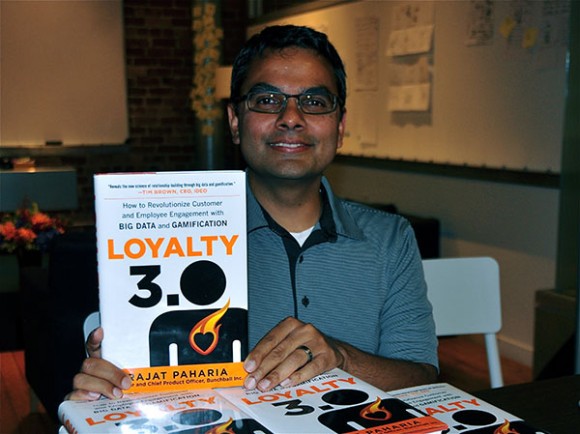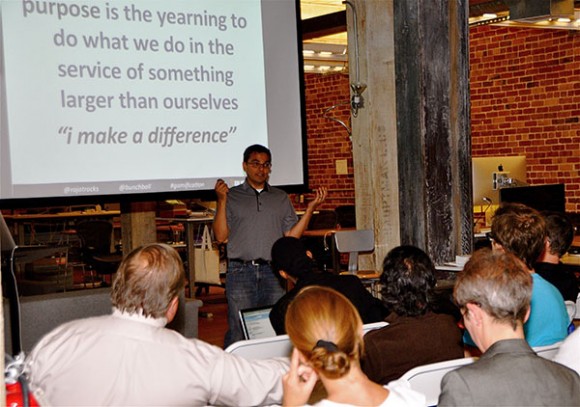aNewDomain.net – Rajat Paharia’s new book, Loyalty 3.0, is an in-depth guide on the cultivation of loyalty, for yourself or your company. Loyalty 3.0 discusses three key steps — motivation, big data and gamification. I spoke to Paharia and gave the book a long, hard look.

Image credit: Julie Blaustein
The premise of the book revolves around Big Data and its role in getting your employees to engage in specific productivity-increasing activities. In turn, these activities create positive rewards and results. The employees, the author predicts, are then motivated to play games or engage with online-learning software that, potentially, increases their productivity at work.
The concept of Loyalty 3.0, Paharia explains, is the Next Big Thing. Consider: Firms like Pandora, Netflix, Spotify and Apple iTunes have already overturned the communications and entertainment market.
Each company uses an engagement strategy based on Big Data, utilizing streams of data customers provide and, subsequently, the company has a hold on its audience’s loyalty.
Data is everywhere. Smartphone activity, GPS, IP addresses, sensors, RFID Chips, online purchases. And then there’s the constant use of Twitter and Facebook. Our data is being cut into pieces for examination and used in ways perhaps no one outside of the NSA and NSA whistleblower Edward Snowden knows, but that’s another story …
Paharia’s primary point in the book is that the correct application of data has the potential to improve all walks of life, whether the audience is students, employees, customers, athletes, buyers or any cohesive group. It’s a powerful argument.
About the Author
Paharia, known to many in his field as the father of gamification, is the founder and chief product officer of Bunchball. Bunchball provides game-oriented strategies for non-gaming businesses.
His firm has worked with the USA Network’s TV Show Club Psych, Warner Bros, Chiquita’s Make Your Way to Rio website and sweepstakes, SAP’s Developer Network, Four Square, Adobe Photoshop’s Level Up and the Nitro for Salesforce App, which won best app at Saleforce’s major conference in 2011.
I especially liked Adobe Photoshop’s Level Up application, which forgoes the traditionally expensive seminars but, rather, lets you examine the ins and outs of complex software programs.
I met Paharia and learned that both his parents were engineers — a heritage, he says, made computers “easy.” Scroll below for my interview with Paharia.

Image credit: Julie Blaustein
The Interview
JB: As a child, what were your favorite games? Was there a particular one that influenced you to where it became your passion?
RP: There was no particular game that I liked as a kid. I was more into video games. I remember Pong was a favorite and one of my first video games. We were into consoles such as the Atari 600 and the Fairchild Semiconductor which was pre-Atari. My father worked at Fairchild as a hardware engineer and my mother was a software engineer. I went on to play with the Apple II and the Mac that I was able to purchase because of my newspaper route. Now I have a startup and three little boys but I have fun playing video games with them on Nintendo’s Wii. We really enjoy Epic Mickey.
JB: What schools did you attend and what was your emphasis in studies?
RP: I followed in my parent’s footsteps and focused on getting good grades. At the University of California, Berkeley as an undergrad I started out as a genetics major. I took a semester of chemistry and then became “undeclared.” As I found working with computers easy, I became a Computer Science major. I returned to grad school at Stanford and focused in Human Computer Interaction Design. I also took courses in communications, business, technology, and robotics. David Kelly of IDEO was my professor and I became his teaching assistant. I worked at IDEO for four years on the Phillips line of Connected Audio Devices. Its product was the boom box. It was ahead of its times.
JB: Did school prepare you for what you are doing today?
RP: Yes. I firmly believe that what we do now at my company Bunchball with gamification is a subset of interaction designs and its creating and crafting experiences that appeal to users. I cover that in Chapter 10 where I discuss how good design, tool kits and motivating people through data all lead to loyalty 3.0.
JB: What else influenced and prepared you for your career today?
RP: Several years of working as an engineer got me to look at how things work, how to break them down and understand what motivates people. My understanding of science along with working at IDEO prepared me for what I am now doing at Bunchball.
JB: How did you become known as the one who coined the word gamification?
RP: It’s funny but it’s probably true. I wouldn’t say that I coined the term but what Bunchball did was build a platform in 2007. We did not know what to call it. Barry Kirk, who is now with Bunchball, was using the word gamification as a transformation process at the time. We bought the URL Gamification for $9 from GoDaddy. There was also Gabe Zickerman who wrote a couple of books and had a conference, the Gsummit. It was then agreed within the industry that the term gamification would be used.
JB: Can you explain the evolution of data to Big Data? Do you believe it has taken over every aspect of our consumer and businesses lives?
RP: Data from the last 10 years to now has grown exponentially. People’s activities include both implicit and explicit tasks that provide a lot more data today. This availability of data has led to Big Data. As there is more data available now, it can be used as information to craft better experiences.
JB: Your company Bunchball provides a software platform that enables gamification. Could you discuss how it set the stage to write your book?
RP: As a result of working with clients I learned a lot and believe gamification is the future. We have a lot of case studies for the book and also included companies that are not clients. We could have written the book based on theory but with real clients we were able to base the case studies on real situations. The book helped me take the discussion to the next level around loyalty rather than just gamification. This has let me gain more exposure for the industry and position myself as a thought leader.
JB: What barriers of entry are there to companies – or even apps – to integrate gamification?
RP: We need to get data out and get it to the users. The data needs to be tracked and be scalable. There needs to be a unique user ID to track the data. You also need to be able to show customers and users their data to motivate them on their mobile phone or their website. There is also the in-between stage where the data may need to be crunched and interfaces designed. That is where Bunchball’s platform comes into place as it makes it easy to work with the data and display it.
JB: For new companies – or current companies behind the ball – what advice would you offer to allow them to reach the level of Loyalty 3.0?
RP: A company such as Safeway that has its Just for U mobile app is still based just on transactions, but could reach the next level with the gamification applications that foster Loyalty 3.0. So much more can be provided to its customers – reviews of products, rewards, points based on spending and much more.
JB: Can we get a sneak peak at your next endeavor?
RP: There are no other big projects right now in the works. I’m back to my day job at Bunchball. The book was my side project and that is now complete. Writing this book has absolutely brought exposure of Loyalty 3.0 to people. And I love that. It clearly articulates what Loyalty 3.0 is and establishes it as a credible area.
Loyalty 3.0: How to Revolutionize Customer and Employee Engagement with Big Data and Gamification is available now. For aNewDomain.net, I’m Julie Blaustein.
Based in San Francisco, Julie Blaustein is a senior photojournalist here at aNewDomain.net. She also contributes to Bub.bliciou.us. A startup addict, Julie has served in various capacities at Photobucket, CitySearch, GeoCities, JamBase and Commission Junction. An avid sailor and triathlete, Julie’s email is jblaustein@aNewDomain.net. Follow Julie @julierb and on Google+ at +Julie Blaustein. Here’s her gift guide — done with our San Francisco-based editor Mike Rothman.












